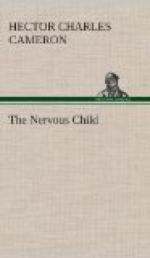Two of the three qualities which we have mentioned as characteristic of the child’s mind are concerned in the causation of habit spasm. In the early stages the movement is sometimes due to imitation, but the susceptibility of the child to suggestion plays the chief part in determining its persistence. It is an interesting speculation how far tricks of gesture, attitude, or gait are inherited and how far they are acquired by imitation. A child by some characteristic gesture may strikingly call to mind a parent who died in his infancy. A whole family may show a peculiarity of gait which is at once recognisable. It is told of the son of a famous man, who shared with his father the distinctive family gait, that when a boy his ears were once boxed by an old gentleman who chanced to observe him hurrying to overtake his parent, and who resented what he took to be an act of impertinent caricature. In the reproduction by the child of the habitual actions of his parents, heredity is largely concerned, but imitation too plays its part. In habit spasm the force of imitation is clearly seen. A child who has developed a habit spasm of one sort or another will readily serve as a model to other children. The malady will sometimes spread through a school almost with the force of a contagious disorder. A child affected in this way may prove an unwelcome guest. The little visitor with a trick of contorting his mouth and grimacing is apt to leave his small host an expert in faithfully reproducing the action. A cough that is genuine enough in one member of the family may produce a crop of counterfeits in brothers and sisters.




